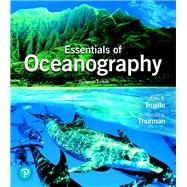For courses in oceanography.
Dive in to oceanography with trusted content and innovative media
As the bestselling brief book in the oceanography market, Essentials of Oceanography combines dynamic visuals and a student-friendly narrative to bring oceanography to life. The text’s engaging features and the extensive suite of animations and videos keep students interested and excited about the material.
The 13th Edition creates an interactive learning experience that provides tightly integrated text and digital offerings to make oceanography approachable and digestible for students. An emphasis on the process of science throughout the text provides students with an understanding of how scientists think and work. The new edition also helps students develop the scientific skill of practicing and interpreting data with new Exploring Data features supported by Mastering Oceanography coaching activities. A new Creature Feature provides fun facts about marine animals to engage students.
Also available with Mastering Oceanography
By combining trusted author content with digital tools and a flexible platform, Mastering personalizes the learning experience and improves results for each student.Built for, and directly tied to the text, Mastering Oceanography enables an extension of learning allowing students a platform to practice, learn, and apply outside of the classroom.
Note: You are purchasing a standalone product; Mastering Oceanography does not come packaged with this content. Students, if interested in purchasing this title with Mastering Oceanography, ask your instructor for the correct package ISBN and Course ID. Instructors, contact your Pearson representative for more information.
If you would like to purchase both the physical text and Mastering Oceanography search for:
0135185629/9780135185629 Essentials of Oceanography Plus Mastering Oceanography with Pearson eText -- Access Card Package, 13/e
Package consists of:
- 013489152X / 9780134891521 Essentials of Oceanography
- 0135175143 / 9780135175149 Mastering Oceanography with Pearson eText -- ValuePack Access Card -- for Essentials of Oceanography, 13/e








